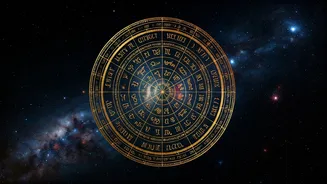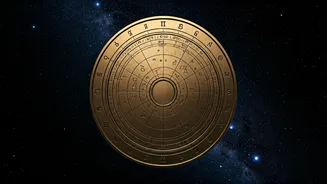Origins of Astrology
The origins of astrology are deeply rooted in ancient civilizations, particularly in Mesopotamia, where the earliest known astrological practices emerged.
These early astrologers, observing the movements of the sun, moon, and visible planets, believed that these celestial bodies held the key to understanding earthly events and human destinies. Over time, these observations evolved into systematic astrological systems. The Babylonians are credited with developing the zodiac, dividing the ecliptic into 12 segments corresponding to constellations. This early form of astrology focused primarily on predicting events of state, such as wars, harvests, and the reigns of kings. The practice spread through trade and conquest, influencing other cultures. The Greeks adopted and adapted Babylonian astrological principles, integrating them with their own philosophical and scientific frameworks. Greek astrologers expanded the scope of astrology to include individual horoscopes, adding a dimension of personal prediction and self-understanding. Hellenistic astrology laid the groundwork for the astrological systems that continue to influence astrology today.
Core Astrological Concepts
Understanding astrology requires grasping several core concepts. The most fundamental is the zodiac, a belt of constellations that the sun, moon, and planets appear to traverse over the course of a year. Each sign of the zodiac—Aries, Taurus, Gemini, Cancer, Leo, Virgo, Libra, Scorpio, Sagittarius, Capricorn, Aquarius, and Pisces—is associated with specific characteristics and influences. Planets, representing different aspects of personality and life, are also central. The sun represents the core self, the moon the emotions, and the other planets symbolize various traits and experiences. The planets' positions at the time of birth, in relation to the signs and houses, form the basis of a birth chart, also known as a natal chart. Houses are the twelve segments of the chart representing different areas of life, such as career, relationships, and health. Aspects, formed by angles between planets, indicate how they interact with each other, affecting the flow of energy and the nature of experiences. These concepts collectively allow astrologers to construct a comprehensive map of an individual's potential, challenges, and life path.
Constructing Birth Charts
The creation of a birth chart is a detailed process that begins with accurate birth data. This includes the date, time, and place of birth, which are essential for calculating the precise positions of the sun, moon, and planets at the moment of a person's arrival. Astrologers use this data, often with the aid of software or astronomical calculations, to generate a chart displaying the celestial positions. The birth chart is a circular diagram divided into twelve houses. Each house signifies a specific area of life, such as the first house representing self-identity or the tenth house associated with career and public image. The positions of the planets within these houses and their relationships, described by aspects, reveal the intricate interplay of energies that shape an individual's character and experiences. The rising sign, also known as the ascendant, is determined by the zodiac sign that was rising on the eastern horizon at the moment of birth and is crucial because it influences the overall perception and how one presents themselves. Understanding this comprehensive interplay of planets, signs, houses, and aspects is the key to interpreting a birth chart and uncovering insights into a person's personality, relationships, and life path.
Types of Astrology
Different branches of astrology provide diverse perspectives and applications. Natal astrology, the most common type, focuses on interpreting birth charts to understand an individual's personality, potential, and life journey. It offers insights into strengths, weaknesses, relationships, and major life events. Horary astrology answers specific questions by constructing a chart for the time a question is asked; the chart provides insight into the answer. Mundane astrology applies astrological principles to larger societal events, such as politics, economics, and natural disasters. Synastry involves comparing the birth charts of two individuals to understand their relationship dynamics and compatibility. Electional astrology helps determine the best time to begin a project or undertaking based on the astrological chart for that time. Each of these branches uses the same core principles but applies them in different contexts. The choice of which type of astrology to use depends on the question being asked and the area of life one wishes to explore.
Astrology Through Cultures
Astrology is a global phenomenon, with diverse interpretations and applications across various cultures. In Western astrology, which has roots in Hellenistic traditions, the focus is often on individualistic interpretation. Chinese astrology uses a different zodiac, based on a twelve-year cycle of animal signs, and emphasizes elements and yin-yang principles. Vedic astrology, originating in India, uses a sidereal zodiac and focuses on karma, dharma, and spiritual growth. Mayan astrology employs a complex system using calendars and cycles to understand time, events, and individual destinies. Each culture has adapted astrological principles to fit its unique worldview, with distinct zodiac signs, planetary associations, and interpretive methods. Despite the variations, the underlying principle remains the same: the belief that the movements of celestial bodies influence human affairs. These cultural variations highlight the versatility and adaptability of astrology, making it a dynamic and evolving practice that continues to resonate globally.
Astrology and Science
The relationship between astrology and science is complex and often contentious. Science operates on principles of empirical evidence and falsifiability, while astrology relies on correlations and interpretations that are difficult to verify through scientific methods. Critics argue that astrological predictions are often too general to be considered accurate and that the concept of celestial bodies influencing human lives lacks scientific support. Research studies examining the correlation between astrological predictions and real-world events have produced mixed results, with most failing to find statistically significant evidence. Proponents of astrology argue that the scientific method may not be suitable for studying the subtle influences astrology explores. They suggest that the complexities of astrological interpretations and the role of free will may make it difficult to establish clear cause-and-effect relationships. Despite the ongoing debate, the scientific community largely dismisses astrology. The lack of verifiable evidence and the absence of a plausible mechanism for astrological influence continue to fuel skepticism, while astrologers continue to explore and refine their practice, often emphasizing its psychological and symbolic value.
Astrology in Modern Life
Astrology has maintained a significant presence in contemporary society, impacting various aspects of life. It’s a popular source of entertainment, with horoscopes found in newspapers, magazines, and online platforms. Many people use astrology for self-exploration and understanding their relationships, personalities, and life paths. The practice is gaining momentum as individuals seek guidance in decision-making, particularly in areas like career choices, relationships, and personal growth. However, astrology's influence extends beyond personal use. It often affects business and marketing strategies, influencing consumer behavior and product launches. It is also found in therapeutic practices, where some practitioners integrate astrological insights to better understand their clients. Despite the scientific skepticism, astrology persists and thrives, demonstrating a remarkable ability to adapt and connect with individuals. Its presence underscores a continuing interest in understanding ourselves and our place in the cosmos, even amidst a rapidly changing and increasingly complex world.











